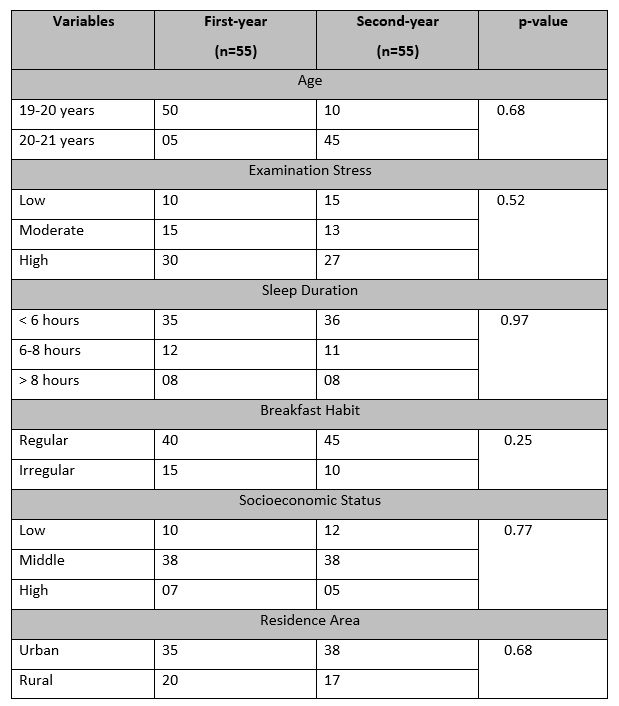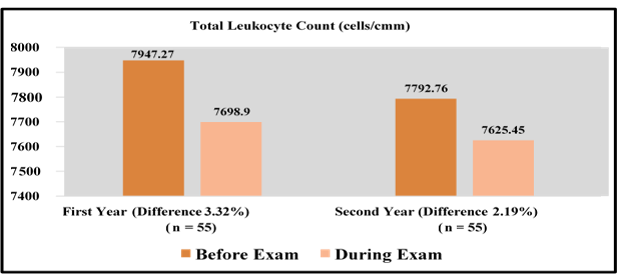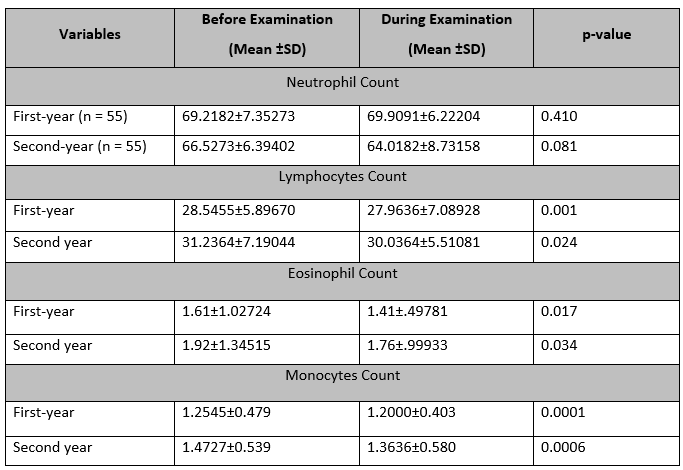By Rehnaz Sheikh1, Uzma Riaz2, Saba Leeza3, Masood Nabi Noor1, Hanna Khair Tunio3, Javed Ahmed Lighar4, Masood Ahmed Unar5
- Physiology Department, Peoples University of Medical and Health Sciences for Women, Shaheed Benazir Abad, Pakistan
- Pharmacology Department, MBBS MC, Mirpur, Pakistan
- Physiology Department, Baqai Medical University, Karachi, Pakistan
- Community Medicine Department, Peoples University of Medical and Health Sciences for Women, Shaheed Benazir Abad, Pakistan
- Pharmacology Department, Shaheed Benazir Bhutto Medical University, Larkana, Pakistan
DOI: https://doi.org/10.36283/PJMD13-1/014
How to cite: Sheikh R, Riaz U, Leeza S, Noor MN, Tunio HK, Lighar JA, Unar MA. Assessing Physiological Responses: Exam Stress and Leukocyte Count in Medical Students at PUMHSW, Nawabshah. Pak J Med Dent. 2024;13(1): 75-80. Doi: 10.36283/PJMD13-1/014
Background: Medical students are confronted with substantial academic and psychological stressors during their education. Studies report that examination stress can have a noteworthy effect on the leukocyte count of students. This study aimed to evaluate the physiological effects of examination stress on the total and differential leucocyte cell count in medical students at Peoples University of Medical and Health Sciences for Women, Nawabshah.
Methods: A cross-sectional comparative study was conducted from April to October 2019, with 110 MBBS students, divided into two groups of 55 students using a non-probability randomized sampling technique with first-year and second-year female students, whereas hypertensive, diabetic, and with any psychiatric disease were excluded. Blood samples were taken before and during the examination. Data were analyzed by SPSS version 23. All the continuous variables were analyzed by the t-test for Mean±S.D while all the numerical variables were analyzed by Student’s t-test.
Results: Pre-exam complete blood count (CBC) test reports of first-year students showed Neutrophils, Lymphocytes, Eosinophil, and Monocytes cell counts of 69.2182, 28.5455, 1.61, 1.2545 cell /microliter whereas complete blood count during exams showed 69.909, 27.9636, 1.41and 1.2000 cells/ microliter. In the second-year student, complete blood count before and during the exam showed Neutrophils 66.5273 to 64.0182, Lymphocytes 31.236 to 30.036, Eosinophil 1.92 to 1.76, and Monocytes 1.473 to 1.364 cells/microliter, the decreased values showing that there is an influence of exam stress on white blood cells.
Conclusion: Exams in medical schools can be stressful enough to induce a substantial decrease in blood cell parameters among medical students.
Keywords: Exam stress, Leukocytes, Physiological effects.
Education is widely regarded as one of the most important phases of human life because it is education that opens the door to success and creates the characteristics of a successful citizen. Stress has become a hot topic in the academic community and our culture. Academic institutions have different work settings compared to non-academic and therefore one would expect the difference in symptoms, causes, and consequences of stress in the two sets1. Stress in academic institutions can have both positive and negative consequences if not well managed2,3. The complex learning atmosphere can also cause serious medical complications in students’ lives, which can contradict the benefits that one can expect after graduating from university4. Academic stress among students has long been studied, and stressors such as too many tasks, rivalry with other students, failures, a lack of pocket money, poor relationships with other students or lecturers, family or home issues, and exams, are considered some of the most significant stressors5. Owing to the competitive climate, the young student population is exposed to the stress of higher professional education6,7.
Throughout their academic, psychological, and existential preparation, medical students face considerable academic, psychological, and existential stress7-10. Exam tension has been shown to have an important influence on blood cell parameters in seven studies. The regular levels of various blood cells, including white blood cells, can be altered by continuous stress on blood parameters11,12. Academic tests in secondary school are challenging enough to trigger changes in blood cell parameters. There was a substantial decrease in the number of eosinophils, basophils, lymphocytes, and monocytes in this sample, as well as a rise in neutrophils count seen in a study11,13. Relationships between work-related psychological and physical stress responses and counts of white blood cells (WBCs), neutrophils, and lymphocytes in 101 daytime workers14. This trend of stress and anxiety is also seen in a study in Karachi15. This study was conducted to document the effects of examination stress on white blood cells and differential cell count in medical students of Peoples University of Medical and Health Sciences for Women SBA.
Data was collected after approval by the Research Ethics Committee (REC) as per office reference No 446-51 dated 06th April 2019. Peoples University of Medical & Health Sciences for Women, Shaheed Benazir Abad (PUMHSW). After obtaining written consent from participants, 2 ml of the venous blood sample was taken in an Ethylene diamine tetra acetic acid (EDTA) contained tube for complete blood count (CBC) and given to diagnostic and research laboratory PUMHSW.
Samples were taken twice, one before the examination (4 weeks) and the second during the examination. With the help of the Slovene, formula sample size was calculated. A total of 110 students were recruited from both years through the non-probability randomized sampling technique. Only healthy first-year and second-year female MBBS students and hypertensive, diabetic, and with any psychiatric disease were excluded.
Students were divided into two groups to determine the comparative effect of examination stress on blood parameters. The first group comprised the students who were studying in the first year (55 students). The second group comprised the students who were studying in the second year (55 students). After the collection of data from respondents first professional MBBS students of Peoples University of Medical & Health Sciences for Women, Shaheed Benazir Abad, the data were analyzed by SPSS version 23. All the continuous variables were analyzed by the t-test for mean standard deviation. All the numerical variables were analyzed by Student’s t-test. Final results were presented by using tables, graphs, and charts.
The participants of the study were female medical students of MBBS and almost all residents of Sindh Province and Asian race. All the results of parameters like examination stress, sleep duration, breakfast habit, and socioeconomic status were statistically non-significant. Table 01.
Table 1: Showing the demographic characteristics of participants

p-value <0.05 is considered significant.
In this study, the mean Total Leukocyte Count ± SD during the examination of students in the first year was 7698.90±1492.67 cells/microliter which was insignificantly lower as compared to the before examination mean Total Leukocyte Count ±SD was 7947.27±1620.56 cell/microliter. There was no significant decrease in Total Count during the examination as compared to before the examination among the students of the first year (p-value = 0.131). (Figure 1)

Results are presented as Mean ± Standard Deviation
Figure 1: Comparison of Mean value of Total Leukocyte Count (cells/cm) of MBBS students before and during examination
In this study, the mean Neutrophil Count ± SD during the examination of students in the first year was 69.909±6.222 which was insignificantly higher as compared to before examination mean Neutrophil Count ±SD was 69.218±7.353. There was no significant increase in Neutrophil Count during the examination as compared to before the examination among the students of the first year (p-value = 0.410).
The mean lymphocyte count ± SD during the examination of students in the first year was 27.9636±7.08928 % which was lower as compared to before examination mean Lymphocytes Count ±SD was 28.545 ±5.897. There was a highly significant decrease in lymphocyte count during the examination as compared to before the examination among the students of the first-year p-value = 0.001.
Table 2: Comparison of Mean value of Neutrophils, Lymphocytes, Eosinophil, and Monocyte Count in MBBS students before and during examination (n = 110)

Results are presented as Mean ± Standard Deviation. p-value <0.05 is significant (student’s t-test)
The mean Eosinophil Count ± SD during the examination of students in the first year was 1.41±.497 which was lower as compared to before examination mean Eosinophil Count ±SD was 1.61±1.027. There was a significant decrease in Eosinophil Count during the examination as compared to before the examination among the students of the first year (p-value 0.017).
In this study, the mean monocyte count ± SD during the examination of students in the first year was 1.2000±0.403 which was lower as compared to before examination mean monocyte count ±SD was 1.2545±0.479. There was a highly significant decrease in monocyte count during the examination as compared to before the examination among the students of the first year (p-value=0.0001).
Examination stress is a sensation of pressure anxiety experienced by many medical students in the days leading up to and during academic examinations. It normally happens during the revision time before exams, as well as right before and during the exams. Though a moderate amount of stress is important for retaining motivation and preparing for exams, excessive stress can be harmful. Stress generated by academic examination shows significant variation in hematological variables9. These variations comprise an increase in platelets, neutrophil count, and red blood cells while eosinophils, lymphocytes, and monocytes are reduced in number. With elevated hemoglobin, the number of large red blood cells increases. However, it has been suggested that stress-induced pro-inflammatory cytokine development can trigger hemopoietic cell proliferation9.
Shahida et al, found in their study that first-year and final-year students were more in trouble 75 and 71% respectively as compared to the students of second and third-year batches due to the vast academic curriculum followed by frequency of examinations16. Qahtani et al noted in their study that the major factor associated with perceived stress was long hours of study, examination, very tight time schedules, language problem, and place adjustment17.
The results of this study showed a significant effect on the blood cell variables. Stress can affect the hemopoietic and immune systems by releasing cytokines and cortisol, resulting in an increase in white blood cells18-19. Certain hematologic parameters such as neutrophils, platelet counts, and mean volume of the cell (MCV) were found to be increased during the students’ examination stresses, and lymphocyte counts were found to be reduced. Hemoglobin, red blood cells, and other parameters were not significantly affected. Our results are inconsistent with the earlier Qureshi et al10. report which shows an increase in neutrophils, platelet counts and lymphocyte decreases. The impact of study stress on hematological measurements was studied by Maes et al and they found that the stress of examination increased considerably hematocrit, HB, MCV, MCH, and MCHC20. Stress-inducing production of cytokine inflammation has been suggested to stimulate hematopoietic cell proliferation21. The hemo concentration, caused by fluid shifts from intravascular to extravascular spaces, concentrated in non-diffusible blood components, may explain an increase in neutrophils, platelets, PCVs, and MCV following a stressor. In comparison with pre-intervention examination stress levels, the level of neutrophils and platelets has been significantly reduced. Following 6 weeks of practice, the level was further reduced22,23. The stress of examination is also associated with decreased numbers of monocytes and lymphocytes. And some studies show high levels24,25.
It is recommended that further studies be carried out on a larger number of subjects and male students. This would help to determine if there are gender differences in response to stress. It is also recommended to construct a stress questionnaire that may be more appropriate for the local population.
Examination stress is associated with a significantly decreased eosinophil, monocyte, and lymphocyte count among first-year and second students during the examination. So, it has been observed in this study that exam stress can affect the important hematological parameters that can influence the overall performance of students.
None.
The authors declared no conflict of interest.
The proposal was approved by the Ethical Review Committee of Peoples University of Medical and Health Sciences for Women, Shaheed Benazir Abad. Pakistan (Registrar 446-51 dated 06/04/2019). The anonymity and confidentiality of the data were respected throughout the study.
Informed consent was taken from the patients.
RS was the main researcher; she gathered the data. UR, SL did the proofreading. MNN, SN, and JAL were involved in the literature search and data analysis. MAU finalized the data and structured the article and corresponding author.
- Chang K, Lu L. Characteristics of organizational culture, stressors and wellbeing: The case of Taiwanese organizations. J Managerial Psychol. 2007;22(6):549–598. https://doi.org/10.1108/02683940710778431
- Stevenson A. Workplace stress and the student learning experience. Qual Assur Educ. 2006;14(2):167-178. DOI:10.1108/09684880610662042
- Maydych V, Claus M, Dychus N, Ebel M, Damaschke J, Diestel S, Wolf OT, Kleinsorge T, Watzl C. Impact of chronic and acute academic stress on lymphocyte subsets and monocyte function. PLoS One. 2017 Nov 16;12(11):e0188108. doi: 10.1371/journal.pone.0188108.
- Grawitch MJ, Trares S, Kohler JM. Healthy workplace practices and employee outcomes. Int J Stress Manag. 2007;14(3):275–293. https://doi.org/10.1037/1072-5245.14.3.275
- Ongori H, Agolla J. Occupational stress in organizations and its effects on organizational performance. J Manag Res. 2008;8:123-135. DOI:10.5296/JMR.V8I3.9554
- Agolla J, Ongori H. An assessment of academic stress among undergraduate students: The case of the University of Botswana. Educ Res Rev. 2009;4:063-070. https://academicjournals.org/article/article1379600680_Agolla%20and%20Ongori.pdf
- Reddy KJ, Menon KR, Thattil A. Academic stress and its sources among university students. Biomed Pharmacol J. 2018 Mar 25;11(1):531-537. https://dx.doi.org/10.13005/bpj/1404
- Kunwar D, Risal A, Koirala S. Study of Depression, Anxiety and Stress among the Medical Students in two Medical Colleges of Nepal. Kathmandu Univ Med J (KUMJ). 2016;14(53):22-26.
- Rosenzweig S, Reibel DK, Greeson JM, Brainard GC, Hojat M. Mindfulness-based stress reduction lowers psychological distress in medical students. Teach Learn Med. 2003;15(2):88–92. https://doi.org/10.1207/S15328015TLM1502_03
- Qureshi F, Alam J, Khan MA, Sheraz G. Effect of examination stress on blood cell parameters of students in a Pakistani medical college. J Ayub Med Coll Abbottabad. 2002 Jan-Mar;14(1):20-22. https://pubmed.ncbi.nlm.nih.gov/12043327/
- Shawesh F, Khdeir A, Alzaruge R, Abu-Alqasim M, Kharbash A, Elazomi A. Effect Of Examination Stress On Blood Cells Parameters Among Medical Technology Students In The University Of Zawia, Libya. ejpmr. 2020;7(1):171-176.
- Sharma N, Gupta V. Effect of Examination Stress On Haematological And Haemodynamic Parameters In Students. JMS SKIMS. 2012 Dec 27;15(2):153-156. https://doi.org/10.33883/jms.v15i2.254
- Sani M, Mahfouz M, Bani I, Alsomily AH, Alagi D, Alsomily NY. Prevalence of stress among medical students in Jizan University, Kingdom of Saudi Arabia. Culf Med J. 2012;1(1):19-25.
- Nishitani N, Sakakibara H. Association of psychological stress response of fatigue with white blood cell count in male daytime workers. Ind Health. 2014;52(6):531–534. https://doi.org/10.2486/indhealth.2013-0045
- Rehmani N, Khan QA, Fatima SS. Stress, Anxiety, and Depression in students of a private medical school in Karachi, Pakistan. Pak J Med Sci. 2018;34(3):696–701. https://doi.org/10.12669/pjms.343.14664
- Shaikh S, Shaikh Ah, Magsi I. Stress Among Medical Students of University of Interior Sindh. Med Channel. 2010;16(4).
- Al-Qahtani MF, Alsubaie ASR. Investigating Stress and Sources of Stress Among Female Health Profession Students in a Saudi University. J Multidiscip Healthc. 2020;13:477–484. https://doi.org/10.2147/JMDH.S255781
- Ravi M, Miller AH, Michopoulos V. The Immunology of Stress and the Impact of Inflammation on the Brain and Behavior. BJPsych advances. 2021;27(Suppl 3):158–165. https://doi.org/10.1192/bja.2020.82
- Lacey K, Zaharia MD, Griffiths J, Ravindran AV, Merali Z, Anisman H. A prospective study of neuroendocrine and immune alterations associated with the stress of an oral academic examination among graduate students. Psychoneuroendocrinology. 2000;25(4):339–356. DOI: 10.1016/s0306-4530(99)00059-1
- Maes M, Van Der Planken M, Van Gastel A, Bruyland K, Van Hunsel F, Neels H, et al. Influence of academic examination stress on hematological measurements in subjectively healthy volunteers. Psychiatry Res. 1998;80(3):201–212. DOI: 10.1016/s0165-1781(98)00059-6
- Pietras EM. Inflammation: a key regulator of hematopoietic stem cell fate in health and disease. Blood. 2017;130(15):1693-1698. doi: 10.1182/blood-2017-06-780882.
- Subramanian S, Elango T, Malligarjunan H, Kochupillai V, Dayalan H. Role of sudarshan kriya and pranayam on lipid profile and blood cell parameters during exam stress: A randomized controlled trial. Int J Yoga. 2012;5(1):21–27. DOI: 10.4103/0973-6131.91702
- Al-Zamely HAN, et al. The effect of stress of academic examination on some physiological parameters of boy students of veterinary medicine College – University of Al-Qadisyia. Al-Qadisiya Journal of Veterinary Medicine Sciences. 2012;11(1).
- Mahassni S, Eskandar AA. Exam Stress and Immune Cells and Antibodies in Saudi Female University Students. J Biochem Tech. 2019;5:89-95.
- Alhmoud JF, Farah HS, Al-Qaisi T. The Changes in Some Hematological Parameters among University Students Due to Stressful Conditions During and after Examinations Period. Indian Journal of Forensic Medicine & Toxicology. 2021;15(1):1181-1186. https://doi.org/10.37506/ijfmt.v15i1.13578.
This is an open-access article distributed under the terms of the CreativeCommons Attribution License (CC BY) 4.0 https://creativecommons.org/licenses/by/4.0/
